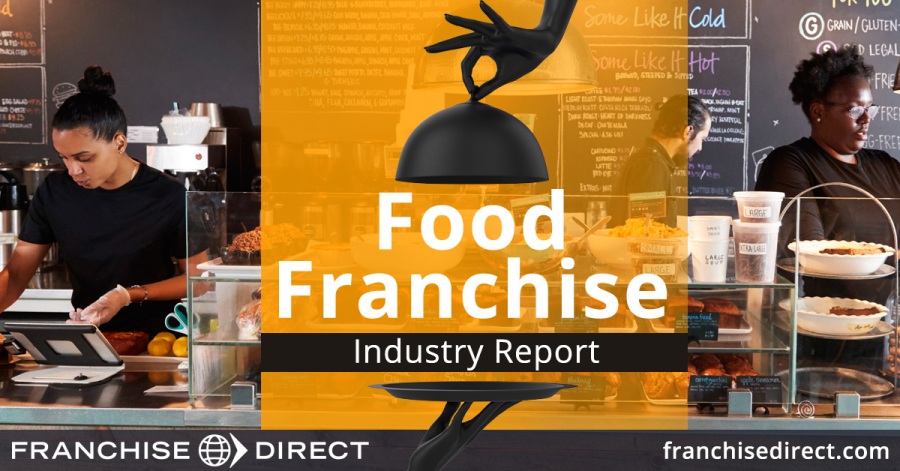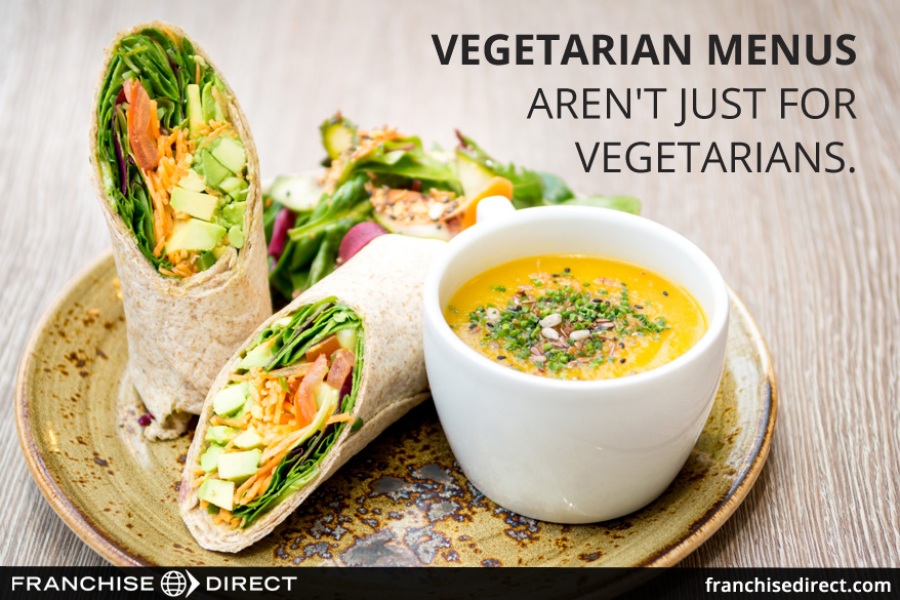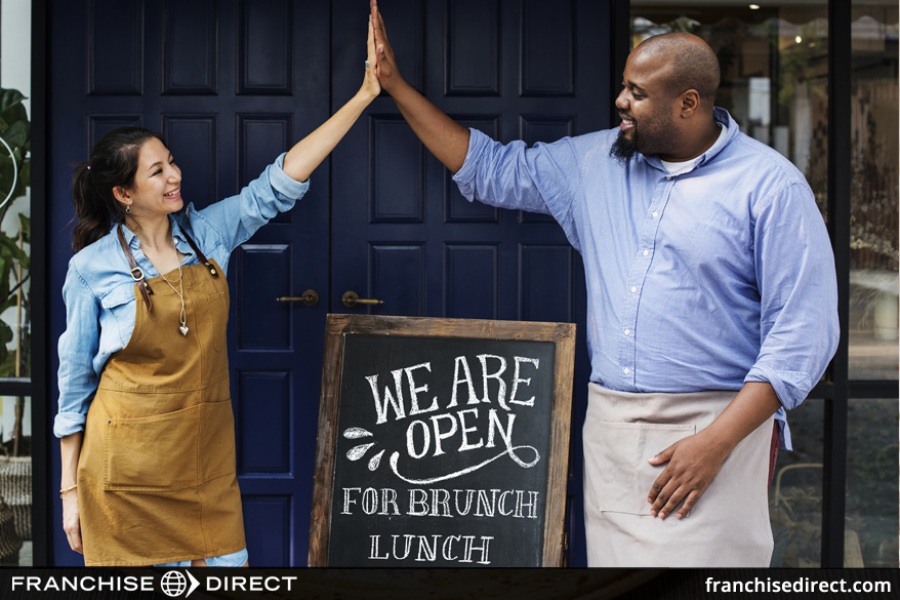🕒 Estimated Reading Time: ~9 minutes

Food Franchise Industry Overview
The bedrock of the entire franchise industry, food franchises account for an estimated 30% of the total franchise establishments in the U.S., and nearly 60% of the direct employment by franchises. And these figures don’t even include food-related franchises that are categorized as retail instead of a quick service or full service restaurant.
Below is an overview of the major food franchise segments. Something to note is franchises can crossover between the given segments. Also, there are several sub-categories within the major categories.
Bakery Franchises: These franchises focus on certain product areas for their business e.g. bread, muffins, bagels, croissants, pastries, donuts and other sweet goods. A number of franchises in this area have menus that feature other items like sandwiches, soups, etc. to stabilize income.
Coffee Franchises: The coffee franchise industry is well-developed and competitive. And there’s no wonder why. Coffee is second only to water in beverage popularity in the U.S., and consumption continues to increase. Many coffee franchises have other sources of revenue—including baked goods or sandwiches.
Fast Food Franchises: With an estimated 25% of total U.S. franchise establishments across all industries, fast food is the most common franchising segment. Food production in fast food restaurants, also known as quick service restaurants (QSRs), is focused on immediate consumption. Fast food meals are commonly taken out or delivered. However, some fast food franchises offer limited on-site seating.
Full Service Franchises: Full service franchise restaurants encompass a range from casual family-style eateries to upscale restaurants. Meals from full service food franchises are typically eaten on-site, although takeout or delivery service may be provided.
Ice Cream & Frozen Yogurt Franchises: The demand for frozen desserts is more evenly distributed throughout the year than it was a few decades ago. Customization has become a feature of many ice cream franchises as those franchises took lessons from the resurgence of the frozen yogurt franchise segment.
Juice and Smoothie Franchises: Franchises in this segment have seen a boost from the general public’s turn towards healthier food options. Furthermore, regulations such as banning soda machines from school have led to franchises, like Jamba Juice, creating vending machines for its wares.
Pizza Franchises: Quick and convenient, pizza is a food franchise niche that people can reliably depend on. Because of that dependability, pizza industry growth isn’t showing any signs of slowing down. And as delivery has come to the forefront as a necessary business component—not a perk—pizza franchises have been showing the way.
Retail Food Franchises: Over the past several years, the convenience store industry has challenged the other food franchise industry segments by increasing its food offerings, particularly the segments that offer quick, on-the-go items. Additional retail food franchises include liquor stores and caterers.
Vending Machine Franchises: While it’s true many vending machine companies are business opportunities, there are some franchise options. The vending machine food franchise segment is a bit of a catch-all grouping with machine-featured offerings going well beyond the traditional snacks and sodas to anything from cupcakes to smoothies.

Currently Impactful Food Franchise Trends
Here’s a look at a couple of trends that made a big impact on the food franchising world within the past year of 2020—and appear like they will have a significant impact on food franchising for the foreseeable future.
Are Ghost Kitchens the Next Wave in Food Franchising?
Even before a pandemic forced dramatic changes in the restaurant world, ghost kitchens were already making waves.
What is a ghost kitchen, you ask?
A ghost kitchen is a shared working space for multiple restaurant concepts to prepare food. In addition, these spaces reduce financial overhead by delivery- or to-go-only operation. No dining rooms or servers. By foregoing the on-site dining experience to serve customers within a certain area around the location, they can offer a diverse menu of food options at reduced cost levels.
Could the concept shake up food franchising?
It could be said that ghost kitchens are already impacting the food franchising world, especially when you consider the concept has already been a feature of the food industry of other countries for a while.

As for the U.S. market, when any new trend comes along, a franchise offering will be available quickly. Combo Kitchen is a newer food franchise that allows “a franchisee to incorporate up to four different food concepts from an exclusive list of proven brands.” According to the franchisor, franchisees and their staff will be fully trained on how to prepare the menu items from each of the restaurants they select for their kitchen.
Another new franchise in the U.S. sporting the ghost kitchen concept is The Local Culinary, the brainchild of longtime Turkish restaurant industry entrepreneur Alp Franko. Meals are planned to take about 30 minutes to reach customers within 10 miles of the preparation hub. The Local Culinary claims nearly 50 delivery-only restaurant brands that franchisees can choose from to offer to their customers.
Existing, highly successful food franchises are getting in on the act too.
A new Taco Bell prototype touches on the emerging trend of ghost kitchens.
At a total size of 1,325 square feet, the new Taco Bell prototype is roughly half the size of a traditional Taco Bell (2,500 square feet). For potential seating, it only consists of an outward-facing bar dining area, essentially making it a hub for off-premise dining—like a ghost kitchen. It also includes a second drive-thru lane dedicated to pick-up only for digital order customers.
Also jumping into the ghost, or virtual, kitchen mix is Dickey’s Barbecue Pit. Over the summer, the company expanded its franchise opportunities to feature the non-traditional franchise model. Area development agreements have already been sold for Chicago, Houston and Orlando, as well as Providence, Rhode Island.
Of the new option in its franchise arsenal, Laura Rea Dickey, CEO of Dickey’s, said:
Virtual kitchens are a unique franchising opportunity that gives us a new and innovative way to capitalize on consumer trends at a low cost. Delivery is a rapidly growing channel in our industry right now, and we believe it will continue to be a preference for guests post-pandemic.
Vegan and Vegetarian Options Increasing
Did you know Taco Bell was the first fast food, or quick-serve, restaurant to offer items certified by the American Vegetarian Association?
The certification happened in 2015, and in September 2019 the fast food franchise took its vegetarian offerings one step further by rolling out its first-ever dedicated in-store vegetarian menu board.
“While other fast food restaurants are just now dipping their toes in the meatless space, Taco Bell has long been a friend to vegetarians,” the company has said in a statement. “The bean burrito has been on the menu for 50 years and is Taco Bell’s second best-selling item.”
But the vegetarian menu isn’t just for vegetarians. Food franchise customers as a whole have shown a shift towards healthier options with an occasional caloric splurge, as noted in our Food Franchise Industry Report 2019. To that end, Liz Matthews, Taco Bell’s global chief food innovation officer, says “We believe that vegetarian food shouldn’t be a compromise; it shouldn’t be limited to one item, and it shouldn’t be just for vegetarians.”

Vegetarians, vegans, and so-called flexitarians are causing shifts at other food franchises as well. For instance, burger franchise MOOYAH Burgers, Fries & Shakes added “The Vegan” to its permanent menu at the beginning of 2020. The option is part of a menu segment the franchise debuted in April 2019 named Lifestyle Burgers. Burgers in this collection include Paleo, Keto, low calorie, vegetarian and gluten-free options.
Vice President of Brand Natalie Anderson Liu says:
We wanted to be able to provide our guests who live a vegan or flexitarian lifestyle with a delicious burger. Our menu is packed with craveable, ridiculous burgers, so the obvious next evolution is to include a vegan burger that hits that mark. We’ve always had the vegetarian option, but now, we’re able to meet the needs of everyone, including those with vegan preferences.
Other food franchises in various stages of development of vegetarian offerings include: Burger King, which sells a plant-based Impossible Whopper, and launched the Impossible Croissan'wich breakfast sandwich nationally over the summer. Dunkin’, which serves a Beyond Meat breakfast sandwich, as well as a wrap version of that sandwich. KFC has done multiple limited-time runs of its “Beyond Fried Chicken,” a partnership with Beyond Meat. And McDonald’s has done a test run with a P.L.T. (Plant-Lettuce-Tomato).
Buying a Food Franchise
Now that you’re up-to-date on industry trends, start your search for the food franchise that suits your needs.
Prior to investing, prospective franchisees should do their research as well as carefully review the franchisor’s Franchise Disclosure Document (FDD) for more detailed information on all systems, procedures and costs associated with that franchise. It’s important to note that while many initial and ongoing costs are detailed in the FDD, there are some costs inherent to business ownership, like employee wages or utility costs, that aren’t.

The Initial Investment and Opening Costs
The amount necessary to open a franchise varies depending on the unique business system and execution requirements.
The opening costs for a food franchisee can depend on many factors, including but not limited to: the franchise fee, land and building costs, training expenses (such as travel and living expenses, not the actual training courses), grand opening advertising and marketing costs, and more.
One of the most important variables in how much it costs to open a franchise is the type of franchise being opened and how big it is. Commonly, the two types of food franchise offered are traditional and non-traditional. Traditional franchises are usually the biggest option. They are typically standalone buildings where the service of the franchise is the only business offering. Non-traditional franchises are smaller, and typically located within another building like airports or gas stations. Other food franchise types include kiosks, trucks, and satellites.
Franchisors offer estimates in their FDD based upon their experience establishing, and in some cases operating, units. However, prospective franchisees should keep in mind these estimates are just that—an estimate. Prospective franchisees should review the figures presented with a business advisor, taking into consideration their unique circumstances, before making the decision to enter into a franchise agreement.
Ongoing Franchise Fees
Throughout the length of the agreement there are costs for being a part of the franchisor’s business system. These costs include items such as royalty fees, charges for technical support, and continued advertising/marketing costs.
The most common is the royalty fee. Royalty fees are assessed for the continued use of the franchisor’s trademarks and patented processes, along with certain types of operational support. In addition to regularly assessed fees, other fees are charged on an “as needed” basis such as audit fees, or costs for additional, non-mandatory, training.
Start your food franchise search today by searching our extensive collection of some of the top food franchises. You'll also find advanced investment information for a number of exciting food franchises in our FDD Research Hub.














